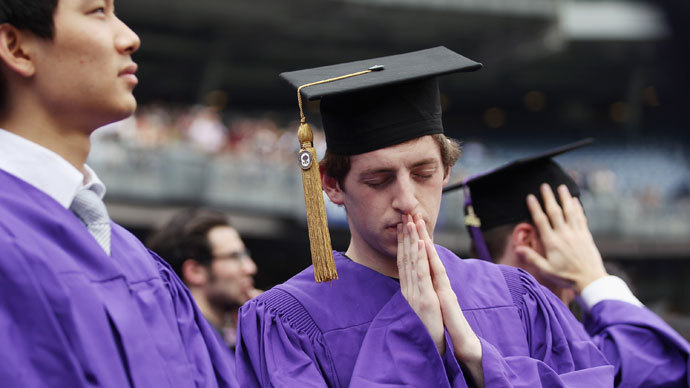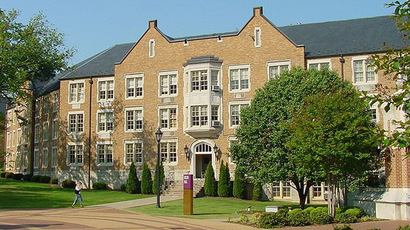US government “profits” from student loans in 2013 surpassed $41 billion

The US government made enough profit from student loans in the last year to provide full Pell Grants of over $5,600 to 7.3 million students. But, like many government financial issues, accounting methods complicate the story.
The $41.3 billion student-loan profit for the 2013 fiscal year -
which ended on Sept. 30 - is actually down by $3.6 billion from
2012, but still enough to out-profit all but two global
companies, Exxon Mobil and Apple.
The numbers give pause since estimates show more than $1.2 trillion in student loan debt exists in the US, more than Americans owe on credit cards.
Yet officials and experts point out that there are various ways of accounting for how the US Department of Education runs the student loan program, and that calling this pure profit is misleading.
The profit number is ultimately tallied by the Congressional Budget Office (CBO) and in what way the CBO chooses to account for the cost of the loan programs can differ. The CBO has traditionally used a procedure mandated in the Federal Credit Reform Act (FCRA) of 1990 to assess the costs of the government’s six loan programs. The method can produce large numbers cited in news reports of late about the wild “profits” off student loans.
But the CBO has acknowledged FCRA doesn’t account for cost of “market risk,” or economic activities that affect if and how borrowers pay back loans. For example, when the economy is in a downturn, borrowers are more likely to be behind on payments, affecting the government’s recovery rates and the overall costs of the program for the Education Department.
“It’s actually neither accurate nor fair to characterize the student loan program as making a profit,” Education Secretary Arne Duncan said in July after new reports on profits from student loans.
Another method - “fair value accounting” - has gained traction with the CBO of late and is touted by experts as giving a more truthful snapshot of the debt programs. The method acknowledges the market risk inherent in lending, and its outcomes show a big difference in government profit. Using it, the 2013 profit goes down to more than $5 billion rather than the over $40 billion being reported by many news outlets. Add previous-year estimates using the method and routine administrative costs, the claims of profit lose a lot of bite. Proponents of this accounting method say there is little to no profit involved in the programs.
This summer, Congress directed the government’s watchdog research agency - the Government Accountability Office - to evaluate the true cost of the federal student loan programs.
In addition, Congress and President Obama agreed this summer to temporarily lower interest rates on student loans, tying rates on loans to the market. Had they not done so, the Education Department’s 2013 profits would have been about $8 billion higher, according to the CBO. Yet the temporary relief will come to an end in coming years, as rates are expected to rise.
Gains off loans in 2013 comprised nearly half of the Education Department’s total outlays, the biggest share since at least 1997.
Effectively subsidizing half of the agency's total operations, the profits have enabled Sec. Duncan to reduce the Education Department’s total cost to the smallest amount since 2001.
The Education Department spent $40.9 billion in 2013, nearly a third less than 2012 and the lowest reported amount since the first year of George W. Bush’s presidency, according to the Treasury Department.
Student loan profits last year exceeded the amount of money for federal Pell Grants given to low-income college students, according to budget documents. The administration has increased Pell Grant funding in part due to reduced costs of student loans, giving the appearance of one group of students subsidizing another.
Senate Majority Leader Harry Reid (D-NV) expressed concern over this in June, saying Democrats “don’t think there should be deficit reduction based on the backs of these young men and women who are trying to go to college.”
Congress plans to explore student debt issues in coming months.
In September, the Senate Health, Education, Labor and Pension Committee began a series of hearings on critical higher education issues, including loan programs.
The average federal student loan holder is more than $26,000 in debt, a nearly 43 percent increase from 2007. Since that year, outstanding federal student loans have almost doubled, worrying Treasury and Federal Reserve officials.
“(It) is a burden which is affecting, for example, the ability of many young people to buy a first home, affecting other purchasing decisions they might make, affecting obviously their overall financial condition,” Federal Reserve Chairman Ben Bernanke said earlier this month. “To the extent that there’s a lot of student debt held by people who are not working, it's obviously yet another drag on recovery.”
The Education Department told the Detroit Free Press Monday that the Obama administration has strived to alleviate debt for students and families.
“The administration has taken steps to improve college affordability, and thanks to collective efforts, students and families are paying lower rates on their loans today than they would have otherwise,” Stephen Spector, US Department of Education spokesman said. “More must be done to bring down the cost of college, and we look forward to continuing to work with Congress, institutions, borrowers, and other stakeholders to make college more affordable.”














